Part of a series of articles titled Park Paleontology News - Vol. 15, No. 2, Fall 2023.
Article
Maintaining the Past: The Role of Facilities Staff in Paleontological Resource Management at Colorado National Monument

Austin Shaffer, Paleontology Intern
Colorado National Monument, Colorado
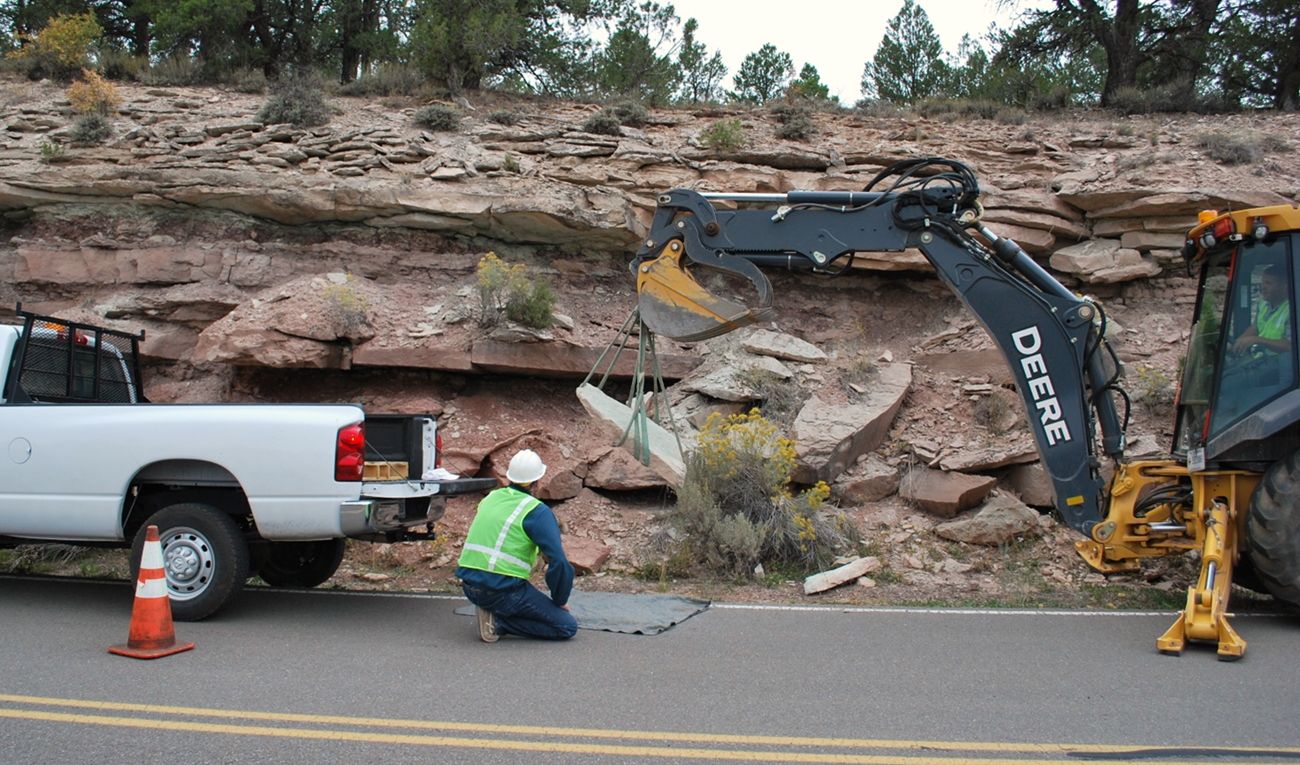
NPS photo.
Introduction
The winding scenic road of Colorado National Monument’s (COLM) historic Rim Rock Drive provides visitors with breathtaking views of the Grand Valley as well as of the spectacular geology of the monument. COLM encompasses numerous geologic units as old as ~1.7 billion years (Ga), many of which are fossiliferous—such as the rich Morrison Formation of the Late Jurassic. With Rim Rock Drive cutting through these layers as it meanders through the park, the exposed rock often breaks loose, falling into the road and the ditches that line it. This geologic activity necessitates regular maintenance by COLM Facilities staff to keep the road open and functioning for visitors and staff alike. Such roadside maintenance places the Facilities staff at COLM in a situation where direct encounters with paleontological resources are highly likely. Fortunately, the various Facilities staff members at COLM, specifically the Maintenance, Trails, and Masonry crews, engage with these resources in a way that not only has prevented unnecessary damage, but has also allowed for the recovery and preservation of important fossil specimens (Figures 1 & 2).
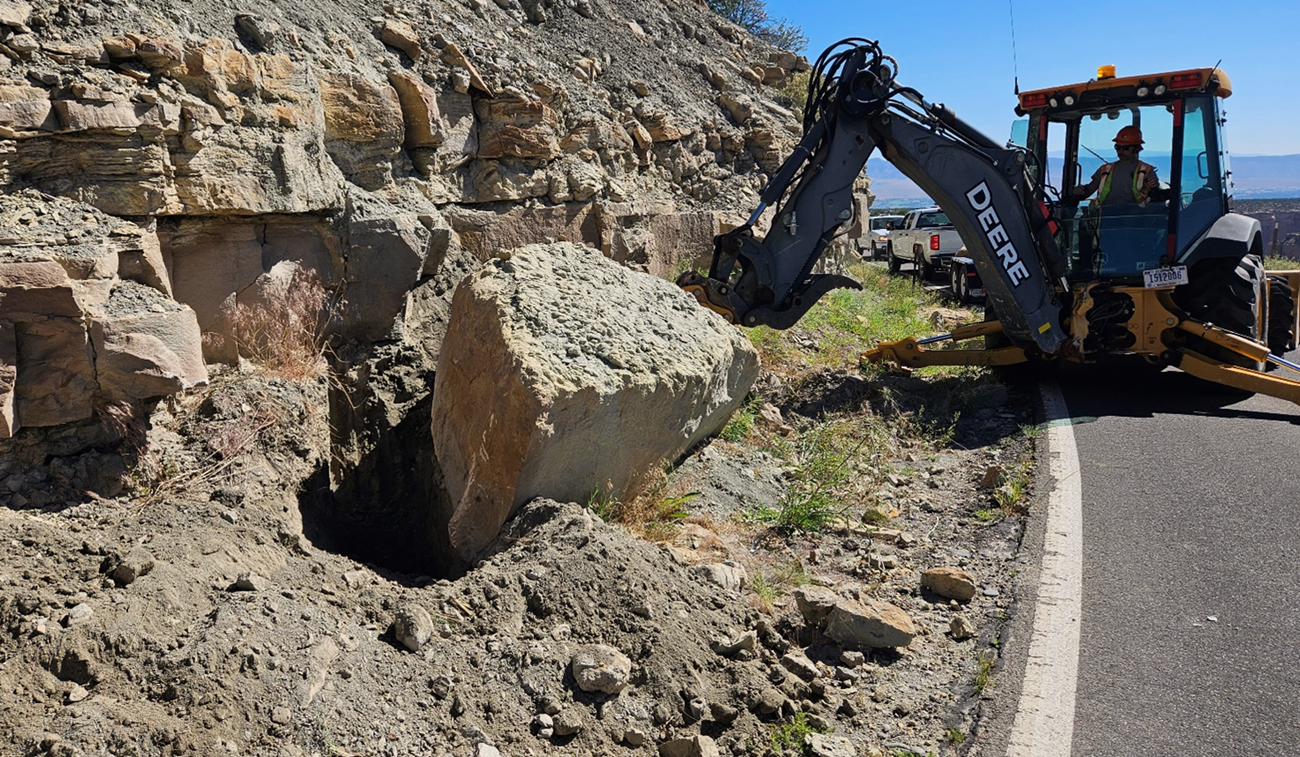
NPS photo.
A History of Preserving Prehistory
Despite staff turnover at the monument, Facilities staff at COLM have nevertheless continued to play an important role in the protection of the park’s paleontological resources for decades. There are few better examples of this relationship than the instances of fossil discovery and recovery that occurred at COLM during the 2010s. While few staff members have worked continuously at the monument since these events occurred, the fossil specimens that they helped preserve will endure for years to come.
At some point in the late 1990s or early 2000s, several large sandstone blocks containing sauropod track casts appeared along the side of Rim Rock Drive. These boulders, hailing from the park’s lower Morrison Formation strata, were initially utilized to prevent unwanted parking on the roadside before their significance was recognized. The fossils at this locality were properly documented during 2004 survey work by Dr. Kelli C. Trujillo, with the recommendation to check the site regularly to prevent significant damage (i.e., vandalism). Following a 2015 site assessment, the decision was made to relocate the blocks to a more secure location away from the roadside. While the initial recovery attempt in November 2015 proved unsuccessful, due to the heavy nature of the blocks, a second attempt a few weeks later was able to relocate the specimens to a maintenance yard at COLM (Figure 3). These fossil track blocks remained there for some time before being relocated to the COLM Resources office where they lie today. Plans exist at the park to eventually utilize these specimens in an interpretive capacity.
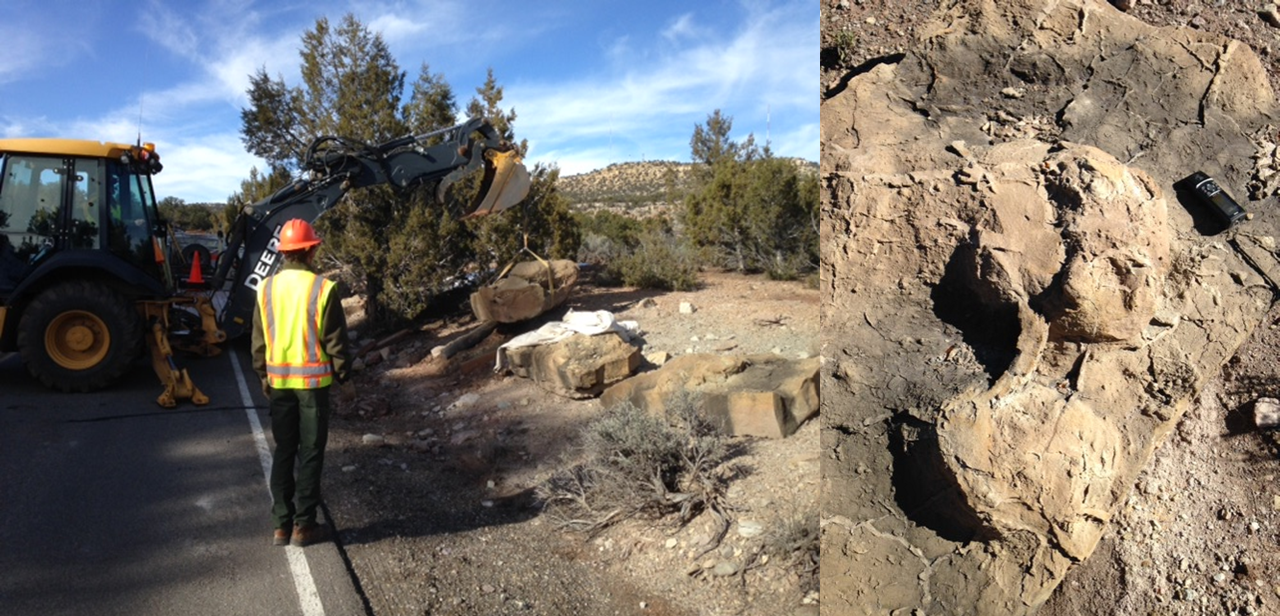
NPS photo.
Not far from the location where the sauropod track blocks were recovered, another vertebrate track site was discovered in the lower Morrison Formation. This site contains trace fossils of multiple taxa, namely ornithopod dinosaur (Dinehichnus socialis) and turtle (Chelonipus isp.) track casts, and was initially reported by Marilyn Sokolosky of Fruita, Colorado in 2005. Soon after, the locality was formally published by paleontologists Martin Lockley and John Foster (2006). After a block containing some of the turtle tracks fell a few winters later, the track slab was collected through collaboration between staff members of the Museum of Western Colorado (MWC) and COLM Facilities staff (Figure 1). This recovered turtle track slab was unveiled at the COLM Visitor Center for the first annual National Fossil Day in October 2010 before eventually making its way to exhibit at MWC’s Dinosaur Journey (Figure 4). Here, the turtle tracks—one of only three specimens known from the Morrison Fm.—are greeted by thousands of visitors annually, a fate which would not have occurred without the help of the Facilities staff at COLM.
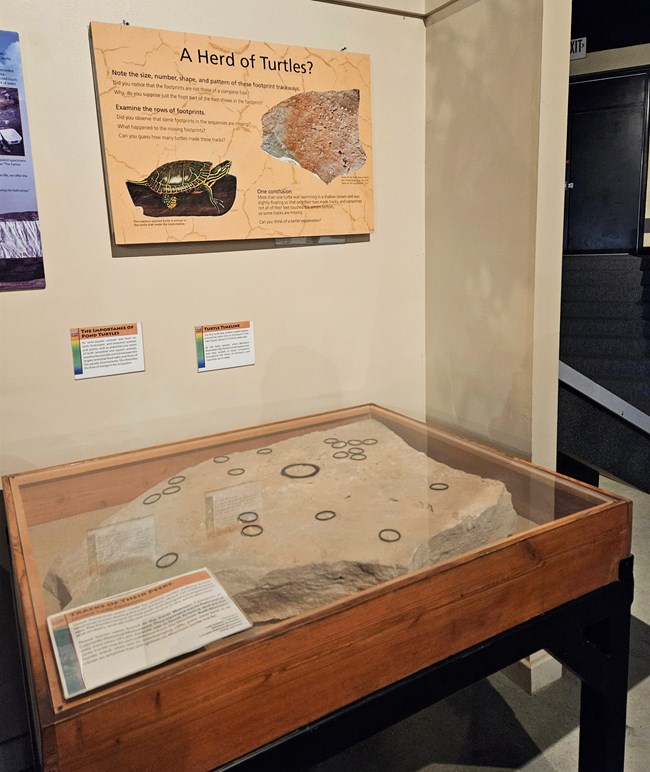
NPS photo.
However, recovery of known fossil specimens is not the only paleontology-related activity that COLM Facilities staff have taken part in over the years. In 2010, Trails worker Jim Robertson discovered a loose tridactyl (three-toed) track cast on a slope of Morrison Formation, once again while working along Rim Rock Drive. Jim identified the track and made sure to avoid damaging the fossil while conducting work in the area, reporting the find immediately thereafter. John Foster, then-curator of MWC at the time, visited the site with COLM staff and discovered additional fossils, including possible crocodyliform swim traces and a slab of potential lizard tracks (which may be some of the only such traces known from the Morrison Formation). The “lizard” and tridactyl track specimens were collected, with the former seeing further examination at MWC and the latter being utilized briefly by Interpretation and Education staff at COLM. Both of these collected specimens warrant additional scientific assessment.
Recent Roadside Recovery along Rim Rock Drive
During the summer of 2023, multiple additional cases of discovery and preservation of fossil specimens by COLM Facilities staff have further illustrated the role that facilities management can have in managing paleontological resources.
While conducting survey work for a 2023 Paleontological Resource Inventory of COLM, the author identified a number of fossil specimens in rockfall along Rim Rock Drive, including loose sauropod track casts, petrified wood, and a large block containing dinosaur bone. These specimens were brought to the attention of the Resources and Facilities staff at COLM, who communicated road maintenance plans, that would begin with the breakup of fallen rock material (such as that containing the aforementioned fossils) in the forthcoming weeks. This situation therefore necessitated additional steps in the planning process in order to protect the fossil specimens. The road was driven by Maintenance staff member Jay Iadonisi and the author, with roadside fossils identified and flagged. Plans for the specimens were developed on a case-by-case basis with input from COLM Chief of Resources Jessica Resnik, NPS Senior Paleontologist Vincent Santucci, and NPS Paleo-Consultant Justin Tweet. The solutions identified for the specimens included recovery, relocation, and repositioning—all of which occurred through the direct assistance of COLM Facilities staff (Figure 2).
Once the identified roadside fossils had been addressed, the breakup of the remaining roadside rocks affecting ditch function commenced. However, while splitting some large rockfall of the lower Morrison Formation, an additional fossil was found. Attempting to split a large block, Facilities staff flipped it over and revealed a large tridactyl track on the underside (Figure 5). Thankfully, the members of Facilities working on the block recognized the fossil and its potential importance, leaving the block alone and alerting Resources staff to the find. The specimen was subsequently relocated by the Facilities staff to a maintenance yard at COLM. The actions of the Facilities staff at COLM were crucial in the discovery and protection of this theropod track—which may be among the largest known tridactyl footprints from the Jurassic of western Colorado.
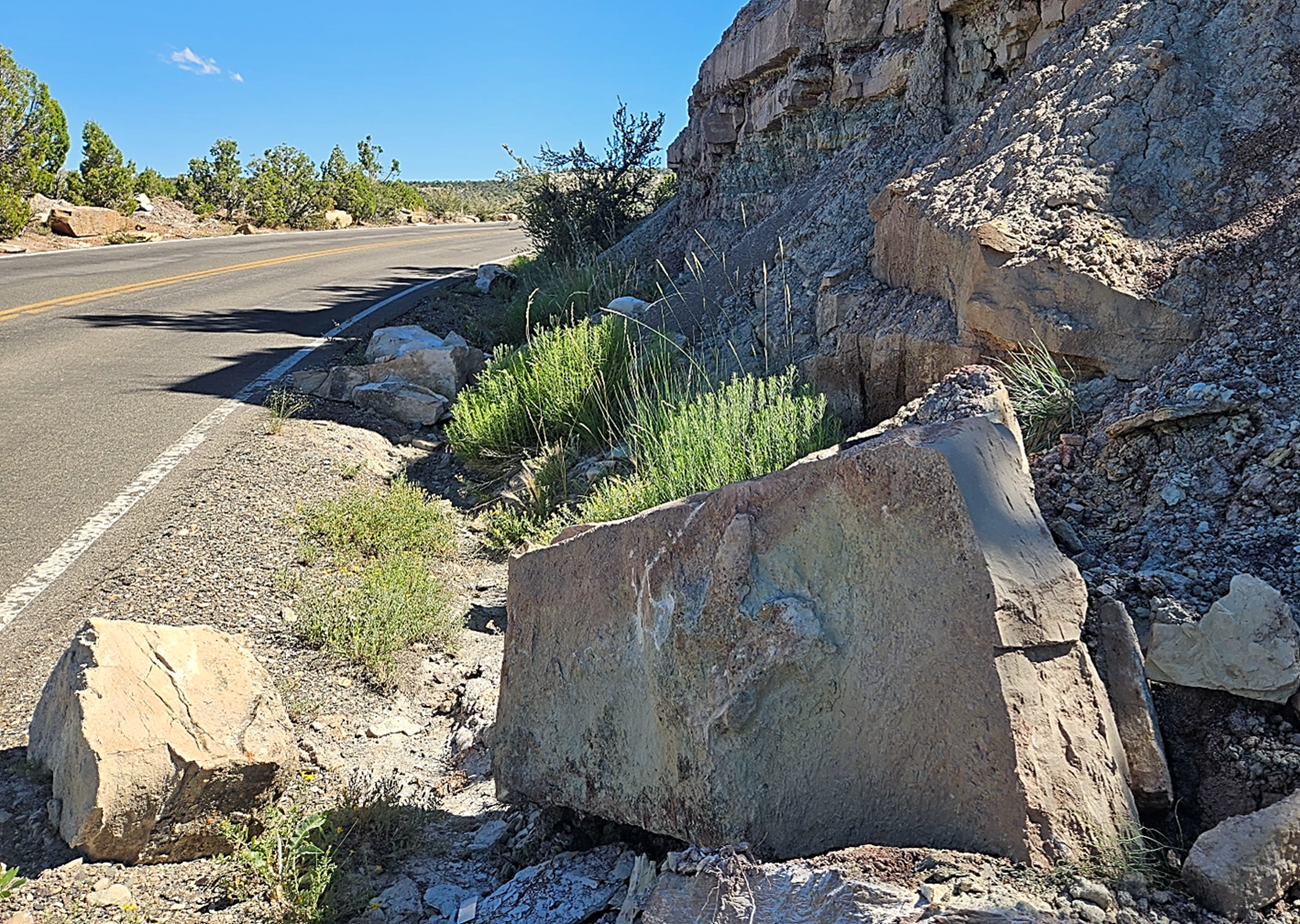
NPS photo.
Maintaining the Past
The examples detailed above highlight just how critical NPS Facilities staff can be in the management of paleontological resources. Over the past two decades, Facilities staff at COLM—from Maintenance to Trails to Masonry—have discovered, relocated, and recovered a number of fossil specimens throughout the park. Their actions have directly provided for proper preservation of important fossil finds at COLM. Many of these finds have gone on to demonstrate potential scientific importance and some have even seen exhibition in a setting where the public is able to engage with the long-lost ecosystems of millions of years prior. Taking all of this into consideration, it is important to recognize the critical resource-management role played by the Facilities staff at COLM, a prime example of how preserving paleontological resources in the National Park Service relies on inter-division cooperation.
References
Lockley, M. G., and J. R. Foster. 2006. Dinosaur and turtle tracks from the Morrison Formation (Upper Jurassic) of Colorado National Monument, with observations on the taxonomy of vertebrate swim tracks. In Paleontology and Geology of the Upper Jurassic Morrison Formation. New Mexico Museum of Natural History and Science Bulletin 36:193-198.
Related Links
-
Colorado National Monument, Colorado—[Geodiversity Atlas] [Park Home] [npshistory.com]
Last updated: September 25, 2023
